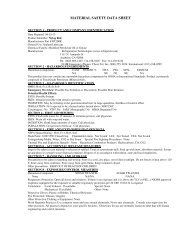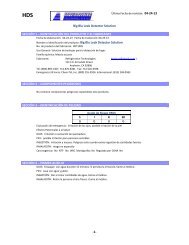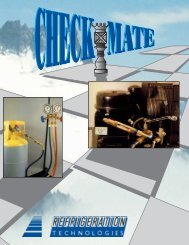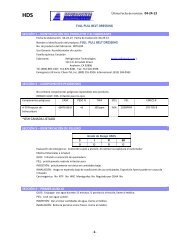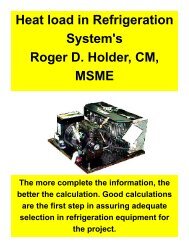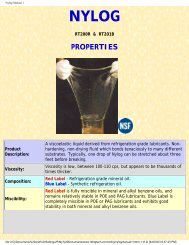Balancing of a Water and Air System (PDF
Balancing of a Water and Air System (PDF
Balancing of a Water and Air System (PDF
You also want an ePaper? Increase the reach of your titles
YUMPU automatically turns print PDFs into web optimized ePapers that Google loves.
108<br />
The enthalpy (total heat see table 11) <strong>of</strong> the air at the leaving WB temperature minus the<br />
enthalpy <strong>of</strong> the air at the entering WB temperature determines the quantity <strong>of</strong> heat in<br />
BTU/LB. that the air picks up while passing through the tower. If this heat gain (enthalpy<br />
difference), is divided by the theoretical enthalpy difference that would result if the air left<br />
the tower at a wet bulb temperature equal to the temperature <strong>of</strong> the water entering the<br />
tower, the result is the Performance Factor. This theoretical enthalpy difference occurs at<br />
zero approach <strong>and</strong> represents a tower performance <strong>of</strong> 100%:<br />
Measure Enthalpy Difference / Theoretical Enthalpy Difference = Performance Factor (PF)<br />
If the water flow GPM <strong>and</strong> the airflow through the tower remain constant,<br />
then the P.F. will remain the same as the heat load <strong>and</strong> WB temperature change.<br />
With this as a basis, a cooling tower can be tested at a reasonable operating condition<br />
<strong>and</strong> from the data <strong>of</strong> this test calculate the performance <strong>of</strong> the tower at the specified full<br />
load conditions. It is possible to prepare a performance curve for the test tower at a given<br />
P.F. It has been found that the most useful curve is to plot approach vs. heat rejection at<br />
specified entering WB temperature, test water flow GPM <strong>and</strong> test P.F. From this curve,<br />
the engineer can determine if the condenser water system will satisfy the requirements <strong>of</strong><br />
the operation <strong>of</strong> the tower at a wide range <strong>of</strong> operating conditions. See Example A in<br />
Appendix 13.2.<br />
Cooling Tower Terms<br />
EWT = Entering water temperature ºF (ºC)<br />
LWT = Leaving water temperature ºF (ºC)<br />
EWB =<strong>Air</strong> entering tower wet bulb ºF (ºC)<br />
LWB =<strong>Air</strong> leaving tower wet bulbº F (ºC)<br />
GPM = Gallons <strong>of</strong> water per minute over<br />
d = <strong>Air</strong> density in lbs. per cubic ft. leaving (see tables 9)<br />
R = Range across tower = EWT - LWT<br />
A =Approach to wet bulb = LWT - EWB<br />
h = Enthalpy <strong>of</strong> air at a wet bulb temperature <strong>of</strong> EWT (see table 11)<br />
h1 = Enthalpy <strong>of</strong> air at LWB (see table 11)<br />
h2 = Enthalpy <strong>of</strong> air at EWB (see table 11)<br />
P.F. = Tower performance capacity factor. This is a percentage <strong>of</strong> the heat picked up by<br />
the air in passing through the tower to the amount it would have picked up if it had left<br />
the tower saturated at the EWT tower at test tower = (h2 – h3)/ (h-h3).<br />
THR = Total heat rejected by tower in BTU per minute = GPM x 8.337 x (EWT - LWT)<br />
108




